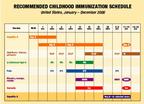Recommended Childhood Immunization Schedule
What's new in the 2000 immunization schedule.
Special report
What's new in the 2000 immunization schedule
Highlights: The rotavirus vaccine is out, inactivated poliovirus vaccine and hepatitis A vaccination are in.
The schedule of recommended childhood immunizations is released every January by the Advisory Committee on Immunization Practices (ACIP) of the Centers for Disease Control and Prevention (CDC), the American Academy of Pediatrics (AAP), and the American Academy of Family Physicians. The schedule for the first year of the new millennium differs from last year's in three significant ways:
- The rotavirus vaccine, which was added to the schedule in 1999, has been removed. The action is in response to studies showing that the vaccine appears to be associated with intussusception in one of 5,000 children who receive it. Doctors should reassure parents that children who received the vaccine before July are not at increased risk for intussusception now.
- An allIPV schedule is now recommended for routine childhood polio vaccination in the US to eliminate the risk of vaccine-associated paralytic polio (VAPP).
- Hepatitis A vaccination has been added to the schedule, but immunization is recommended only in certain areas of the country.
The complete schedule appears on the facing page. Bars indicate the range of recommended ages for each dose. Any dose not given at the recommended age should be given at a subsequent visit. Ovals indicate vaccines to be given if recommended doses were missed or were given earlier than the recommended minimum age. Combination vaccines may be used whenever any components of the combination are indicated and other components are not contraindicated. The following qualifications apply to this year's schedule:
Hepatitis B. Infants born to HbsAgnegative mothers should receive the second dose at least one month after the first dose and the third dose at least four months after the first and two months after the second, but not before 6 months of age. Infants born to HbsAgpositive mothers should receive vaccine and 0.5 mL of hepatitis B immune globulin (HBIG) within 12 hours of birth at separate sites, a second dose of vaccine at 1 to 2 months of age, and a third dose at 6 months. Infants born to mothers of unknown status should receive vaccine within 12 hours of birth, and maternal blood should be tested. If the test is positive, the infant should receive HBIG as soon as possible and no later than 1 week of age. Unimmunized children younger than 18 years may begin the series at any age.
DTaP. The fourth dose may be administered as early as 12 months of age, provided six months have elapsed since the third dose and the child is unlikely to return at age 15 to 18 months. Tetanus and diphtheria toxoids (Td) are recommended at 11 to 12 years of age if at least five years have elapsed since the last dose of DTP, DTaP, or DT. Subsequent routine Td boosters are recommended every 10 years.
Haemophilus influenzae type b (Hib) conjugate vaccines. If Pedvax or ComVax (PRPOMP) is administered at 2 and 4 months of age, a dose at 6 months is not required. DTaP/Hib combination products should not be used for primary immunization in infants at 2, 4, or 6 months of age unless FDA approved for these ages.
Polio. All children should receive four doses of IPV at 2 months, 4 months, 6 to 18 months, and 4 to 6 years. OPV, if available, is to be used only in the following special circumstances: during mass vaccination campaigns to control outbreaks of paralytic polio, in unvaccinated children who will be traveling in less than four weeks to areas where polio is endemic or epidemic, and in children of parents who do not accept the recommended number of vaccine injections. Children in this last group may receive OPV only for the third or fourth dose or both and only after the health-care provider has discussed the risk for VAPP with caregivers. During the transition to an allIPV schedule, physicians should follow recommendations issued by the AAP for using remaining OPV supplies in offices and clinics.
MMR. The second dose may be administered at any visit, provided at least four weeks have elapsed since the first dose and both doses are administered after 12 months of age.
Varicella. Recommended at any visit after the first birthday for children who lack a reliable history of chickenpox. Susceptible individuals 13 years of age or older should receive two doses at least four weeks apart.
Hepatitis A. The darker shading of the bar indicates that the vaccination is recommended in selected states: AZ, AK, CA, ID, NV, NM, OK, OR, SD, UT, and WA. Routine immunization also should be considered for children in MO, TX, CO, AR, MT, and WY. Clinicians should consult their local public health authority for specific recommendations.

. Recommended Childhood Immunization Schedule. Contemporary Pediatrics 2000;1:32.